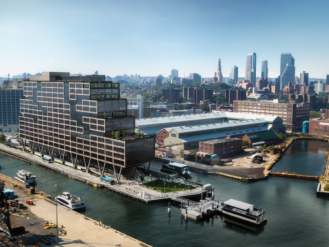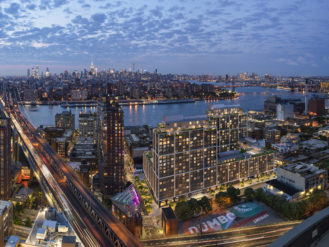The 11 Most Beautiful New Buildings in Brooklyn
Behold the 2018 award-winners: structures by turns elegant, memorable, sustainable and affordable
The building called 325 Kent, on the Domino Sugar redevelopment site, won the award for iconic design (Photos courtesy of the Brooklyn Chamber of Commerce)
Brooklyn can often feel like one giant construction zone, thanks to its boom times. But here and there, when the scaffolding is peeled away, the result of all the noise and dust is revealed to be pleasing to the eyes–even a delight, in the best cases. Those buildings, expressive in design and uplifting for their neighborhoods, deserve recognition.
That’s the role of the 18th annual Building Brooklyn Awards, which will take place Aug. 1 at the 1 Hotel Brooklyn Bridge. The winners have already been announced, comprising 11 recently completed construction and renovation projects, so we can offer a preview of what they look like–and what the judges say about them.
All told, the buildings “represent a great combination of large and small, public and private domains that really run the gamut of how development shapes Brooklyn,” states Rick Russo, acting president of the Brooklyn Chamber of Commerce, which presents the awards. And now the 2018 winners (last year’s laureates can be seen here):
1. Historic Restoration: 158 Clifton Residence
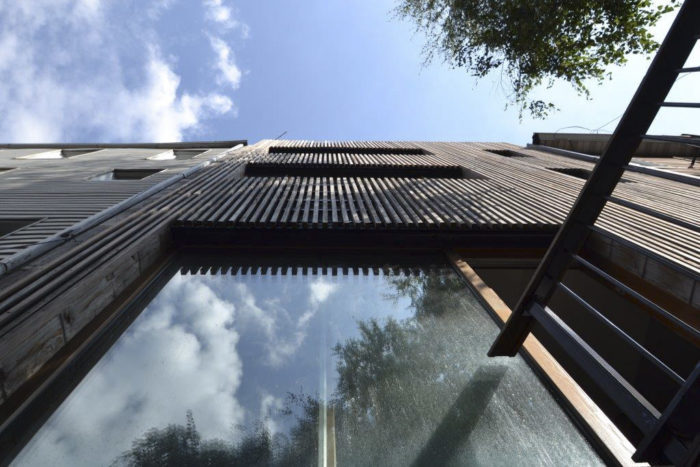
The row house at 158 Clifton Pl. in Clinton Hill is an 1887 row house undergoing gut renovation with recycled materials and energy conservation uppermost in mind. The front facade uses a process of burning the exterior of the wood, a Japanese technique known as shou sugi ban, which protects the wood from the elements. The process allows use of recycled wood that would otherwise be unsuitable for exterior use, according to the awards program. The back of the house uses recycled slats from the Coney Island boardwalk. All told, the residence meets New York’s passive-house standard for energy conservation. Architect: Paul A. Castrucci; builder: Blue Line Construction.
2. Education: District 20 Pre-K Center
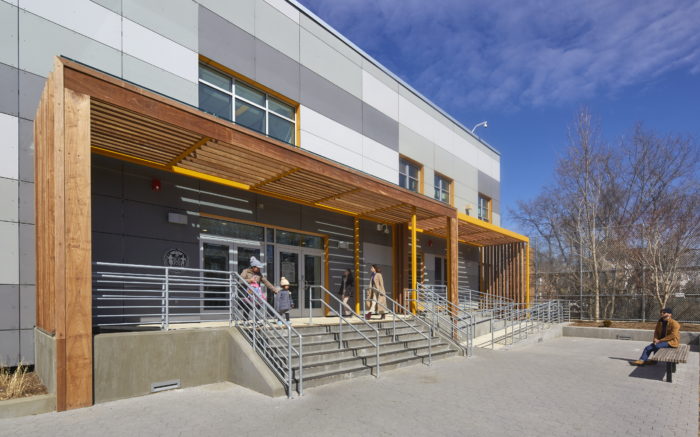
This 18-classroom building in Dyker Heights accommodates 324 students and is one of the largest buildings constructed under the city’s universal pre-K initiative. “Both inside and out,” say the judges, “this lively adaptive re-use project brings a community facility with an engaging, welcoming presence to a unique corner of Brooklyn’s evolving west Bensonhurst manufacturing area and the surrounding residential neighborhood.” Constructed in a former warehouse built in 1925, the building uses a distinctive grey-and-yellow cladding that establishes an interplay of pattern and color that’s carried over to the building’s interior. Architect: Doban Architecture; builder: Citnalta Construction.
3. Open Space: Brooklyn Bridge Park Boat House
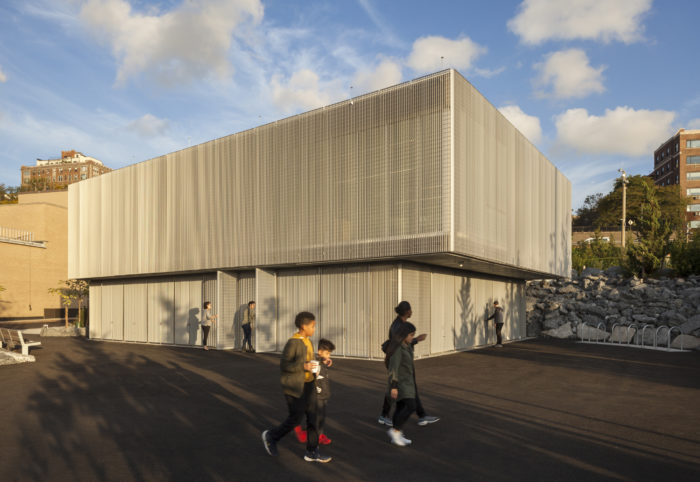
The new Boat House, which sits along the Pier 5 uplands in Brooklyn Bridge Park, is designed to provide open-air storage for kayaks and other boats, along with a multi-purpose room and restrooms, all safely situated above potential floodwaters. “The structure is build to adapt to each hour and season, appearing opaque or translucent, rugged or elegant, depending on the time of day, wrapped with metal grilles creating light and shadow through the day and glowing at night when backlit,” say the judges. Architect: Architecture Research Office; builder: PJS Group.
4. Retail: Supreme Store
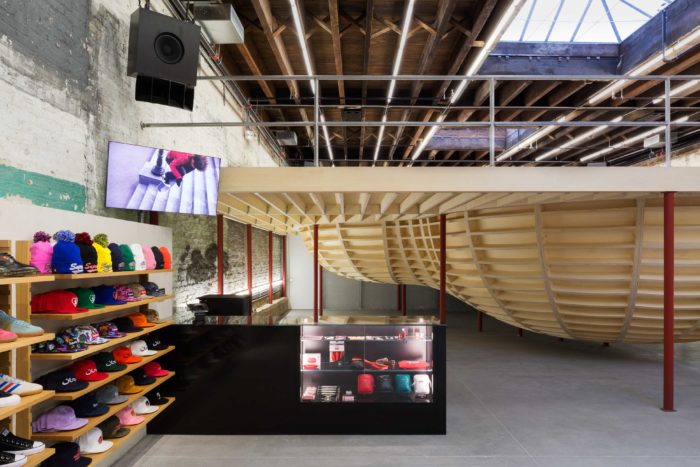
The former ice-cream-truck storage garage in Williamsburg was converted to a retail space for Supreme, the intensely popular skateboarding shop and street-wear clothing brand. The conversion included the construction of an elevated, free-standing skate bowl. The judges appreciated how the new store “kept its old structure and graffiti on the masonry walls to incorporate Supreme’s street culture and vibe,” while the main facade “was restored with the same type of brick to stay consistent with the surrounding community.” Architect: Neil Logan; builder: John Petrocelli Construction.
5. National Grid Award for Energy Efficiency: Il Centro
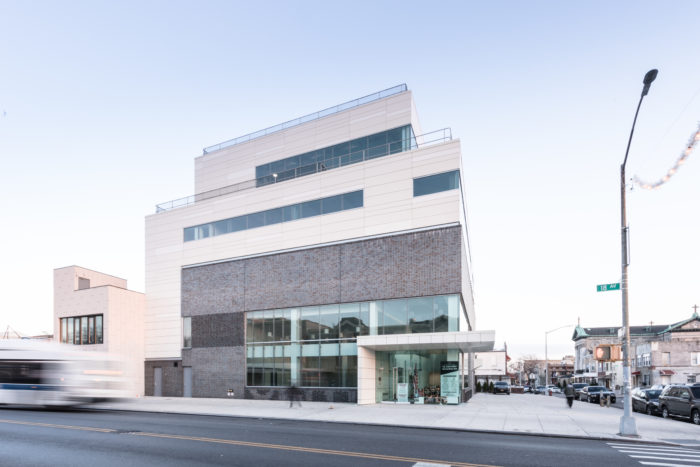
Il Centro, the city’s first and only Italian-American cultural community center, was built to conserve energy in myriad ways. Among the techniques are spray-foam insulation, light sensors, low-flow faucets, and floor-to-ceiling windows to take advantage of natural light. The six-story Bensonhurst building includes classrooms, a library, kitchen, fitness center, high-school-sized gymnasium, community rooms, and an indoor penthouse swimming pool. Architect: Gensler; building: D’Onofrio General Contractors Corp.
6. Residential/Single Family: Porchouse
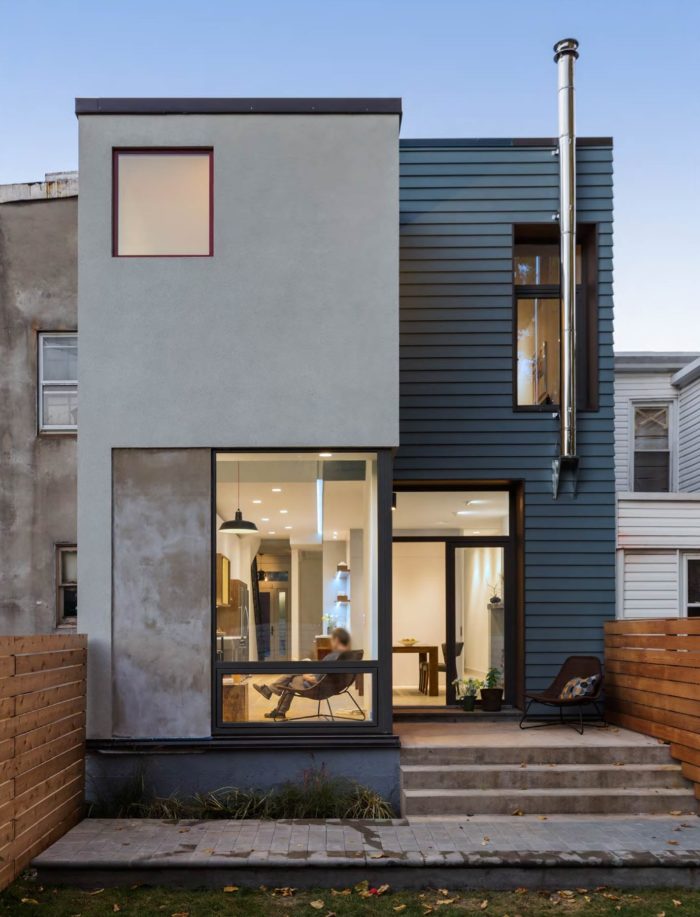
Porchouse is the renovation of an 1879 wood-frame, single-family home in Bedford-Stuyvesant (garden view above). “The historic details of the original home are combined with a smart, practical, modern approach to a dwelling,” say the judges. The interior of the home was opened up, taking advantage of its 20-ft. width, allowing a view of the back garden from the front door. Skylights were added over double-height spaces and the front facade “was renovated to preserve one of the fast disappearing wood frame row houses.” Architect: noroof architects; builder: Great Will 88 Contracting.
7. Residential/Affordable: Greenpoint Landing
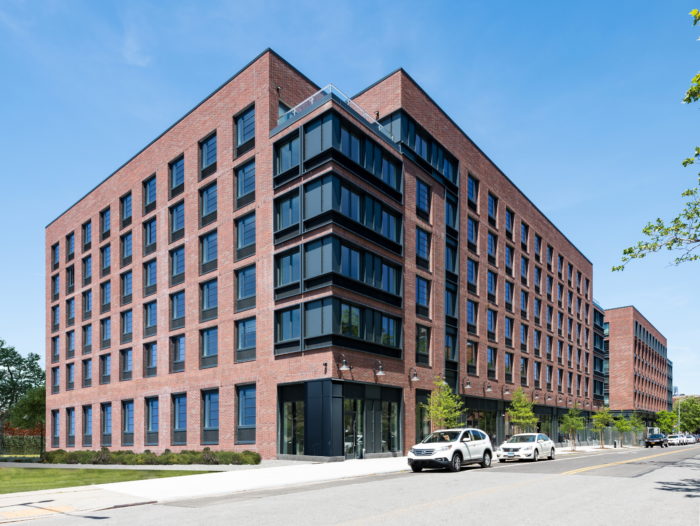
The six-story building at 7 Bell Slip is one of three buildings in the Greenpoint Landing redevelopment project that will provide a total of 294 residential units, all of which are designated 100% affordable. The buildings, made of brick and steel to reflect the neighborhood’s former industrial character, “each provide unique design elements while sharing a common architectural language, with expansive use of natural light, private courtyards, trees and paths,” the judges say. The red brick, according to the architects, “is slightly irregular and hard fired in a carousel kiln,” giving it a rich and varied tonality. Architects: Handel; builder: L&M Builders Group.
8. Residential/Mid-rise: The Brooklyn Grand
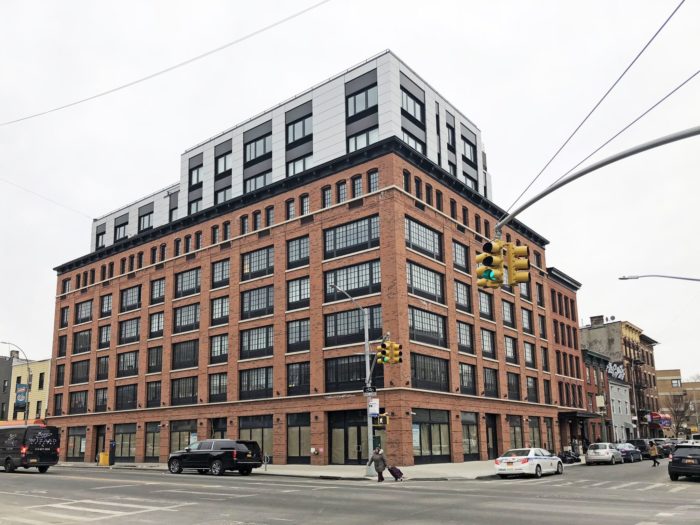
This mixed-use building on Grand Street in East Williamsburg is newly designed to look old, with many subtle touches. The red brick structure, which contains 71 rental units and 10,000 sq. ft. of commercial space, has a base that is “capped with a historical replica cornice that grounds the building and separates the two upper floors,” say the judges. This keeps the scale of the building congruent with industrial warehouses in the neighborhood, but there’s another nuance: the top two floors “are clad in champagne colored metal to evoke the feeling that they were added in this century.” Architect: Gene Kaufman Architect PC; builder: Hollister Construction.
9. Residential/High-rise: Hub
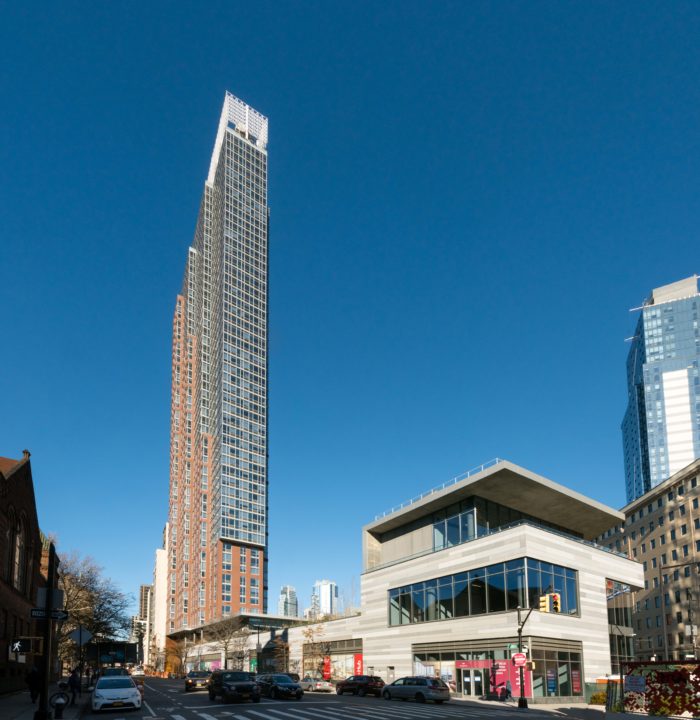
Hub, a new, 55-story skyscraper at the edge of Boerum Hill, is currently the tallest building in Brooklyn. The residential tower contains 600 market-rate apartments and 150 affordable units, “designed to foster a social lifestyle,” say the judges, with more than 40,000 sq. ft. of amenities, including an indoor pool. “Strategies have been employed to emphasize a residential scale and demonstrate sensitivity to the surrounding community,” say the judges, with features including setbacks, contextual window patterns, and a low-rise retail wing with “a unique floating roof.” Architects: Dattner, GHWA; builder: New Line Structures.
10. Iconic Design: 325 Kent
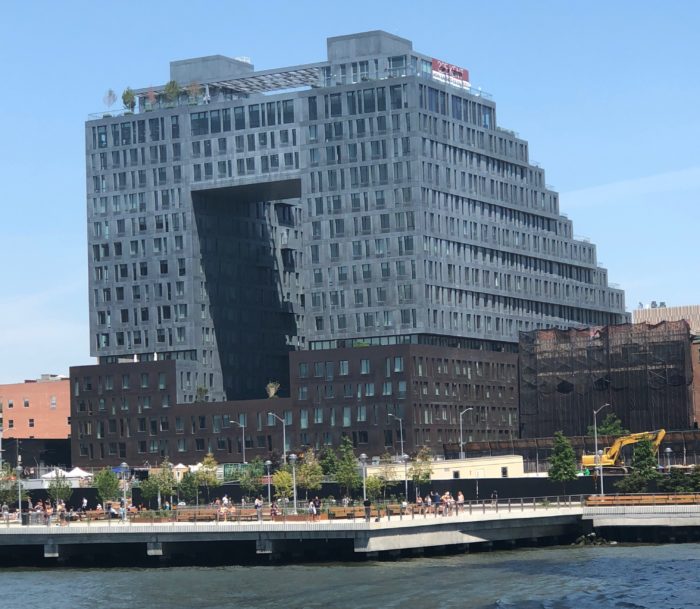
(Photo by Steve Koepp)
One of the most visually dramatic structures to rise lately in New York City is 325 Kent, with its square-donut silhouette and copper and zinc cladding. The residential rental building (522 market-rate units; 104 affordable) is the first to open on the Domino Sugar refinery site, a multibillion-dollar, 11-acre, mixed-use community in Williamsburg being developed by Dumbo-based Two Trees Management. “The building possesses a striking silhouette with a textured, geometric facade, incrementally stepped to provide a visual connection between the existing low-rise neighborhood, the landmarked Refinery Building and future waterfront development,” say the judges. Architect: SHoP Architects; builder: 325 Kent Construction LLC. See more views of the building here and neighboring Domino Park here.
11. Economic Impact: Building 77, Brooklyn Navy Yard
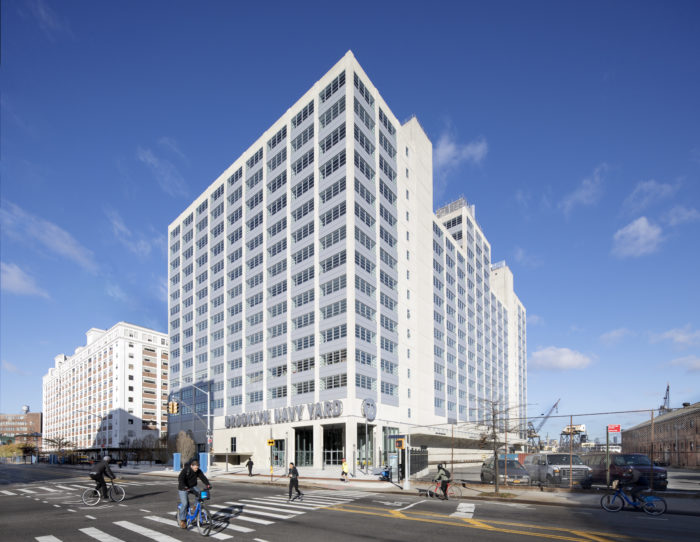
Building 77 is the transformation of a 1-million-sq.ft., World War II era structure into a modern facility for light manufacturing in the ever-expanding Brooklyn Navy Yard. The renovation created openings in portions of a windowless facade and refurbished all systems, creating a brighter, technologically up-to-date space for commercial tenants to modify to their needs for office, design and production work. The ground floor was built to accommodate food producers and vendors, while the outside entranceways were redesigned to foster public gathering. Architects: Marvel, Beyer Blinder Belle; builder: Plaza Construction.






